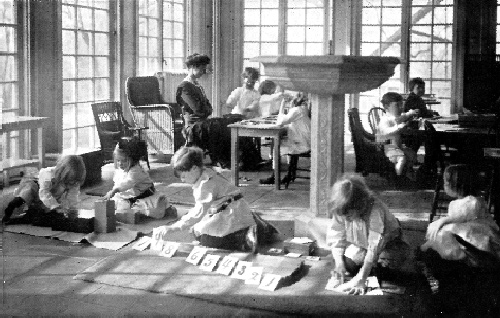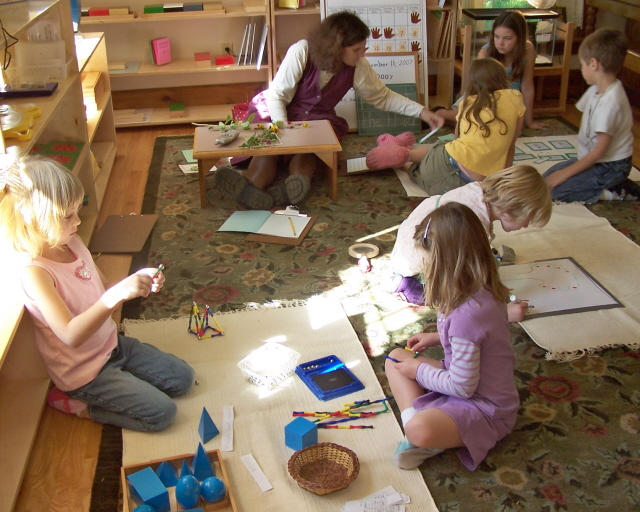
(Almost a century ago)

(Montessori today)
The Montessori Method is a teaching methodology developed in Italy by Dr. Maria Montessori. With the opening of her first school in 1907 in Rome, the term Montessori became associated with schools that use Dr. Montessori’s educational approach to children as well as her precise educational materials tailored for children’s developmental needs. A number of schools around the world implement her approach to education for a wide range of ages. From the moment the child enters the classroom, each step in his education is seen as a progressive building block, ultimately forming the whole person, in the emergence from childhood to adult. All focus is on the needs of the child.
Independence With Cooperation Upon touring a Montessori school, your first observation should include seeing a high degree of independence with cooperation amongst the children. At Country Meadows Montessori as with any other true Montessori school you will NOT find children who simply do as they please, without any rules. Instead you will find engaged, independent children, who are encouraged to do and think for themselves within a set of followed “Ground Rules”. In fact, the level of cooperation through problem solving and self-motivation will astound you. This allows for a peaceful, happily-at-work atmosphere not often seen in typical day-care or school settings. Montessori children show high levels of cooperation and self-reliance by (and without having to be told), picking up after themselves and displaying care and consideration toward their classmates…even among the youngest of the children. And finally, you should observe teachers who sit side by side with their students, not needing to resort to shouting or threatening in order to achieve a peaceful, fun and productive atmosphere. So, how does this all come about? How can these children be so well rounded and cooperatively independent without the traditionally structured school atmosphere? As a parent, you may be wondering, ‘well, they must be talking about children who were already calm, easy-going and advanced types of children. Surely, they aren’t talking about my strong-willed, sometimes defiant, toddler?’ Yes, we are! Both the easy-going and the strong-willed belong in the Montessori classroom. Read on! One reason why both types of children and all of those in between have such a high degree of success are due to the following:
- The Prepared Classroom Environment Montessori classrooms, like the classrooms of Country Meadows Montessori, are carefully created and painstakingly prepared environments where every element of the curriculum, the materials, and the classroom are designed to engage the young learner. You will be able to view that the prepared classroom and everything in it is designed to allow the child to become independent – the materials are child sized and the equipment is laid out in an orderly fashion on low shelves that are easily accessible for the children. The equipment is aesthetically pleasing and is meticulously cared for which encourages the children to take care of it too.
- Absorbing Through The Senses The Montessori approach is based upon the natural laws of human development. Maria Montessori observed that children under six absorb limitlessly and effortlessly from the world around them and in so doing lay down all the foundations for later life – they become adults with all the characteristics and language of the culture into which they have been born simply by living. In this huge task, however, they have some help. They have a special kind of mind that she called an absorbent mind – a strong desire to explore everything around them using their senses and a drive to become independent. She identified certain windows of opportunity for the child that she called ‘sensitive periods’ during which the child is irresistibly drawn to the things he needs to help him develop his full human potential.
- Learning From One Another (the multi-age classroom and teacher/student relationship.) Children between the ages of 2 ½ and 6 are grouped together in their own mini society. The younger children learn from watching the older children and the older ones benefit by helping the younger children. The mixed age group allows the children to develop socially, intellectually and emotionally – it is an essential part of any Montessori school. When you are looking at schools you need to see children of different ages grouped together in this way otherwise the class is missing an important part of the Montessori approach. The teacher/student relationship should “look” a bit different as well. Many schools, teachers take center stage, yet talk about being child-centered. However, in Montessori we speak of the “triad” of child, environment, and teacher, where each part of the triad is as important as the other. Montessori teachers believe that each child possesses many gifts and is not merely an empty mug to be filled by an all-knowing jug (the teacher). This approach demands confident and skilled professionals, like our certified teachers at Country Meadows Montessori, who allow the child to be an active participant in his or her learning.
- The Hands-On Approach The curriculum is divided into four main areas. Practical life not only gives the children the opportunity to practice the skills of everyday life but also helps them to develop concentration and develop co-ordination of mind and body. The sensorial materials capitalize on the fact that children use their senses to learn. Through these materials they are encouraged to order and classify the physical properties of the world they live in. The materials for mathematics help the children to learn and really understand mathematical concepts because they are presented using concrete materials. Children are prepared to write and read from the minute they come into the class through a series of activities that gradually build all the individual skills required so that when they are ready it is just a natural progression. Geography, history, biology, botany, zoology, art and music are covered with a hands-on approach that is based on the fact that children learn most effectively from their own experiences.
- Work Done In Their Own Time In a Montessori school you will see children choosing their activities independently and moving from one activity to the next – always returning things to the shelf after they have used them. You will experience an atmosphere of calm and see young children concentrating for surprising periods of time. Children work individually, in a group or with a friend. The morning should last for a minimum of three hours – three hours in which there is no fixed ‘timetable’. Groups arise spontaneously rather than at a fixed time every day. Maria Montessori observed that this unfettered period of time was essential for the children to develop the kind of concentration that you see when a child becomes involved with something that is essential for his development. There are no time limits for the child – he may work with whatever he chooses for as long as he likes. What is known as the ‘three- hour work cycle’ is another essential feature of the Montessori approach and if you don’t observe this you are not looking at true Montessori.
- Help Only When Needed In a Montessori school the child is guided by a trained adult who will show him how to do the things that he is ready for after which he can work with them independently. The adult observes the child and will not interfere so long as the child is working with the material productively. When a difficulty arises she is able to step in and give help but is always careful never to give more help than is needed. Children work at their own individual pace and naturally develop their own rhythm and work pattern. Each child’s individual needs are assessed through observation so that he is shown new things when he is developmentally ready and new knowledge is always built on what he already knows. Since everything he does in the classroom also prepares for a later activity the child is able to move gradually through activities developing his skills effortlessly. The ‘directress’ is not teaching the child she is putting him in charge of his own learning through his own exploration. This may seem a subtle distinction but it is a key part of the Montessori approach.